Kate Rauner's Blog, page 89
January 28, 2015
Human Hands
Touch your finger to your thumb.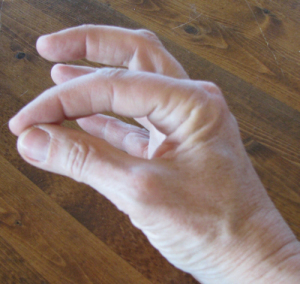
Eons live in what you’ve done.
Million of years would pass
Before we had tools to last
Long enough to find in digs,
Stone instead of bone or twigs.
What good would be our human brains
Without our deftly human hands?
Three million years ago a touch
Could convey to others much.
The grip that once clung to a tree
Joins me to you,
And you to me.
We rightly treasure our magnificent brains – but touch defined what it means to be human, or at least hominid, for millions of years.
livescience.com nationalgeographic.com

January 24, 2015
Weird is Wonderful
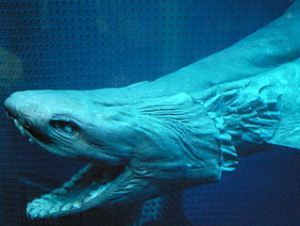 I don’t usually go for the “weird creature of the week” post, but this is too good to pass up. Several outlets covered the capture of a rare deepwater fish, probably because of the great image taken when it was transferred to an aquarium. It’s the frilled shark (Chlamydoselachus anguineus).
I don’t usually go for the “weird creature of the week” post, but this is too good to pass up. Several outlets covered the capture of a rare deepwater fish, probably because of the great image taken when it was transferred to an aquarium. It’s the frilled shark (Chlamydoselachus anguineus).
It seems no one can resist calling the fish a “living fossil” which is a pretty silly term. The frilled shark has been swimming the oceans and adapting as nature requires for as long as any of us. It’s just that some of us encounter changing environments and others – not so much. But it is a weird looking fish.
“The frilled shark has been scaring the bejeezus out of humans who pull it out of the water to find an animal with rows of needle-like teeth in a gaping mouth.” Who can resist that?

January 21, 2015
Ancient Masks Speak – a poem by Kate Rauner

Scraps of linen or papyrus stuck together to make a mummy case or cartonnage. No one’s likely to destroy this example to retrieve the papyrus.
Mummy kings of Egypt,
Millennia gone by,
Wore masks of gold when buried
To meet gods in the sky.
No others could afford the gold,
But all seek the afterlife,
So commoners began to plan
Escape from mortal plight.
Papyrus, glue, papyrus, glue,
From used papyrus cheaper still.
Papyrus, glue, papyrus, glue,
Layers of the mask to build.
Science has discovered
How to separate the sheets
And read the ancient writing
That time could not defeat.
Business papers, letters,
The trivia of life,
Scraps of texts and poetry,
Of happiness and strife.
A bit of Christian gospel,
A fragment some revere.
Could the scribe who inked the words
Have heard with his own ears?
Hundreds if not thousands,
A treasure trove is found.
Destroy one artifact to see
The mundane and profound.
We don’t know if they reached their goal,
These mummied men and women.
These documents won’t tell us
If their souls reside in heaven.
I’m intrigued by the idea of recovering ancient texts from two-thousand year old mummy masks. While scholars will treasure all the writings, it’s a scrap of the Christian Gospel of Mark that grabs the headlines.
“The research team will publish the first volume of texts obtained through the mummy masks and cartonnage later this year. It will include the gospel fragment that the researchers believe dates back to the first century.” LiveScience.com
A mask must be destroyed to recover the papyri, so the process is controversial. Those working on the project have signed non-disclosure agreements, so rumors and suspicions abound. If you happen to have a mummy mask (apparently there are many in private hands), I suggest you not try the methods posted on the Internet in any do-it-yourself attempt to retrieve documents. FacesandVoices

Ancient Masks Speak

Scraps of linen or papyrus stuck together to make a mummy case or cartonnage. No one’s likely to destroy this example to retrieve the papyrus.
Mummy kings of Egypt,
Millennia gone by,
Wore masks of gold when buried
To meet gods in the sky.
No others could afford the gold,
But all seek the afterlife,
So commoners began to plan
Escape from mortal plight.
Papyrus, glue, papyrus, glue,
From used papyrus cheaper still.
Papyrus, glue, papyrus, glue,
Layers of the mask to build.
Science has discovered
How to separate the sheets
And read the ancient writing
That time could not defeat.
Business papers, letters,
The trivia of life,
Scraps of texts and poetry,
Of happiness and strife.
A bit of Christian gospel,
A fragment some revere.
Could the scribe who inked the words
Have heard with his own ears?
Hundreds if not thousands,
A treasure trove is found.
Destroy one artifact to see
The mundane and profound.
We don’t know if they reached their goal,
These mummied men and women.
These documents won’t tell us
If their souls reside in heaven.
I’m intrigued by the idea of recovering ancient texts from two-thousand year old mummy masks. While scholars will treasure all the writings, it’s a scrap of the Christian Gospel of Mark that grabs the headlines.
“The research team will publish the first volume of texts obtained through the mummy masks and cartonnage later this year. It will include the gospel fragment that the researchers believe dates back to the first century.” LiveScience.com
A mask must be destroyed to recover the papyri, so the process is controversial. Those working on the project have signed non-disclosure agreements, so rumors and suspicions abound. If you happen to have a mummy mask (apparently there are many in private hands), I suggest you not try the methods posted on the Internet in any do-it-yourself attempt to retrieve documents. FacesandVoices

January 17, 2015
DNA Ties to Forgotten Neanderthal Ancestors
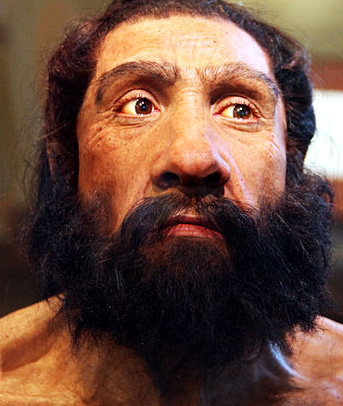
Model of a Neanderthal at the Smithsonian Museum
A bone from a man who lived in Siberia forty five thousand years ago carries a spark from our hominid cousins: one or two percent of his DNA came from Neanderthals. He ate “C3” plants, which include plants such as garlic, eggplants, pears, lentils and wheat. I wonder if he would have liked my home-made hummus.
Neanderthals were already far in his past. I suppose he would have reacted with fear and aggression if he’d met a Neanderthal. I suppose he would have reacted the same way to me. Even so, some modern humans and Neanderthals were intimate. Love? Rape? Something I can’t imagine? I’ll never know. Maybe fiction like the Clan of the Cave Bear is the closest we’ll ever come to understanding.
Neanderthals have gradually become more human in our view. Some of the first Neanderthal bones found were arthritic. That may indicate the person was fed and cared for by relatives, but early interpretations painted Neanderthals as stooped over, animalistic creatures. We’ve learned a lot over the decades. We now know Neanderthals had art, made tools, buried their dead, and conversed.
If I’m a typical modern human whose ancestors passed through Eurasia, I carry that spark too, one or two percent Neanderthal DNA, a small bit of immortality entrusted to the future by my ancient cousins. If we can come to embrace our ancient ancestors as human, perhaps there’s hope for today’s tribes to make peace. Civilization is the trend to view more and more of humanity as “one of us.”
See more about the Siberia find here and here.

January 14, 2015
Possibilities – a poem by Kate Rauner
More time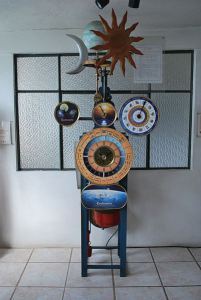
Is what I need.
More time,
I must concede.
Time to improve,
To contemplate,
To exercise
And lose some weight.
Read more books,
And not forget
A simple pleasure,
Watch sunsets.
Get more sleep,
Smell the roses,
Volunteer,
Arrive at closure.
Never speed,
Calmly queue,
Meditate,
And cook more, too.
Visit family,
Hang with friends,
Catch up at work.
I’ve socks to mend.
Twice a decade,
There about,
There is a year
With extra clout.
In twenty fifteen
I must reckon
How best to use
My leap second.
It’s time to start planning. Horologists – experts on measuring time – will add one second to June 30, 2015.
“It’s the 26th time this has happened since atomic clocks started governing our time. The extra second will be tacked on to the final minute of June 30. On that day, the official atomic clocks that keep Universal Coordinated Time will mark the time as 23h 59m 59s, followed by the leap second 23h 59m 60s. July 1 will continue as usual, beginning with 0h 0m 0s.” LATimes.com
We must do things like this because the universe refuses to conform to our notions of perfection – circles, constant rates, stable axes, Platonic shapes. Dratted universe.

Possibilities
More time
Is what I need.
More time,
I must concede.
Time to improve,
To contemplate,
To exercise
And lose some weight.
Read more books,
And not forget
A simple pleasure,
Watch sunsets.
Get more sleep,
Smell the roses,
Volunteer,
Arrive at closure.
Never speed,
Calmly queue,
Meditate,
And cook more, too.
Visit family,
Hang with friends,
Catch up at work.
I’ve socks to mend.
Twice a decade,
There about,
There is a year
With extra clout.
In twenty fifteen
I must reckon
How best to use
My leap second.
It’s time to start planning. Horologists – experts on measuring time – will add one second to June 30, 2015.
“It’s the 26th time this has happened since atomic clocks started governing our time. The extra second will be tacked on to the final minute of June 30. On that day, the official atomic clocks that keep Universal Coordinated Time will mark the time as 23h 59m 59s, followed by the leap second 23h 59m 60s. July 1 will continue as usual, beginning with 0h 0m 0s.” LATimes.com
We must do things like this because the universe refuses to conform to our notions of perfection – circles, constant rates, stable axes, Platonic shapes. Dratted universe.

January 10, 2015
Next, Michael Crichton’s Shuffled Deck of a Novel
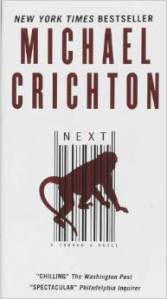 I’ve done a series of posts to look at how popular science fiction books relate to standard writing advice. This post will look at a popular author, Michael Crichton, and one of his novels that gets mixed reviews: Next.
I’ve done a series of posts to look at how popular science fiction books relate to standard writing advice. This post will look at a popular author, Michael Crichton, and one of his novels that gets mixed reviews: Next.
The edition I checked on Amazon had 599 reviews:
18% five stars
18% four stars
22% three stars
23% two stars
19% one star
as always on Amazon, some poor reviews reflect delivery problems and not the content
Averaging just under three stars (which means 58% of reviewers didn’t hate it), this is a surprisingly mixed set of reviews for a popular author. It also surprised me that the book made the New York Times Bestseller list, though that may simply reflect Crichton’s overall popularity.
I wonder if Next was perhaps an experiment in formatting. It feels like a collection of short stories that Crichton split into parts and shuffled together like a deck of cards. The stories are united by the field of genetics and most have overlapping characters. There are tales of body snatching, poaching, living art, bounty hunters, and illegal research; along with cheating spouses and lawyers. Crichton inserted short faux newspaper articles about genetics and the ethical dilemmas the field creates – the ultimate “data dump.” He even completed one storyline with a short faux article to simply tell what happened to the character.
Crichton introduces new characters and storylines throughout most of the book. As the main stories resolve towards the end, an exciting action-packed cliff-hanger in one chapter is followed by a judge explaining legal issues in the next chapter. There were three or four stories I liked and I found myself flipping past chapters to get to the next installment of the story I wanted to read.
Crichton pulls a lot of the storylines together at the end, but I think the book would have worked better for me as a straightforward collection of short stories.
Amazon reviewers who liked the book were fascinated by the world of genetics [“fantastic premise… terrifying implications” says Jennifer Sicurella] and enjoyed the complicated cast of characters. One found Next to be humorous and was “amazed that people didn’t get the joke. This was satire!” [Sally Forth]
Those who did not like the book found it confusing, an “extended info-dump” [Jim Heale] or thought the transgenic animals were implausible. (Personally, I liked the animals better than the human characters.) Apparently Crichton named a disreputable character after a real-life person he dislikes. (I’d expect a traditional publisher to edit that out.)
The book seems to have a message or agenda about the genetics industry. Whether you find the message a useful warning or fear-mongering probably depends more on you than on the book.
Reading Next leaves me with some interesting questions. Once an author becomes famous, will they continue to sell large numbers of books no matter what? For how long?
New authors wish readers would take a chance on an unfamiliar name. The used hardback copy of Next I picked up for $1 at my Friends of the Library sale was listed at $27.95 USA – quite an investment. Maybe inexpensive e-books will allow readers to try unknown authors, but Amazon advertises various editions of Next from $12 to 1��. (I assume the 1�� doesn’t include shipping – lol.)
Oh, and by the way – I think the cover art for Next is pitiful. Clearly, all the publisher needed to do was print Crichton’s name in big letters. Maybe that answers my questions.

January 7, 2015
A Visitor Will Find – a poem by Kate Rauner
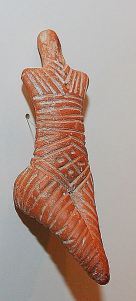
Neolithic “goddess” carving
Welcome Comet Lovejoy
To our northern sky.
Constellations frame your path,
Through Rabbit, Maiden, Bull you fly.
When last you journeyed near the Sun
We humans on the ground
Were mostly still nomadic,
Had no cities, had no towns.
While you were gone we learned to farm,
To write and tally busheled grain,
Domesticated dog and horse,
Built wagons, cars, and planes.
We learned to war and yearned for peace,
Found gentle commerce better
Than conquest of our neighbors,
As trade became our treasure.
Yet still we murder for our gods,
And still we crave for power,
And still we turn our backs upon
The least of sisters and of brothers.
When you return eons hence
I hope you’ll find, in human eyes,
A wiser race is gazing up
Faithful beyond kin and tribe.
This poem quickly veers from space to social science – Steven Pinker’s encouraging book Better Angels of Our Natures – Why Violence has Declined. There’s reason to hope Lovejoy will pass a better Earth next orbit.

A Visitor Will Find

Neolithic “goddess” carving
Welcome Comet Lovejoy
To our northern sky.
Constellations frame your path,
Through Rabbit, Maiden, Bull you fly.
When last you journeyed near the Sun
We humans on the ground
Were mostly still nomadic,
Had no cities, had no towns.
While you were gone we learned to farm,
To write and tally busheled grain,
Domesticated dog and horse,
Built wagons, cars, and planes.
We learned to war and yearned for peace,
Found gentle commerce better
Than conquest of our neighbors,
As trade became our treasure.
Yet still we murder for our gods,
And still we crave for power,
And still we turn our backs upon
The least of sisters and of brothers.
When you return eons hence
I hope you’ll find, in human eyes,
A wiser race is gazing up
Faithful beyond kin and tribe.
This poem quickly veers from space to social science – Steven Pinker’s encouraging book Better Angels of Our Natures – Why Violence has Declined. There’s reason to hope Lovejoy will pass a better Earth next orbit.




